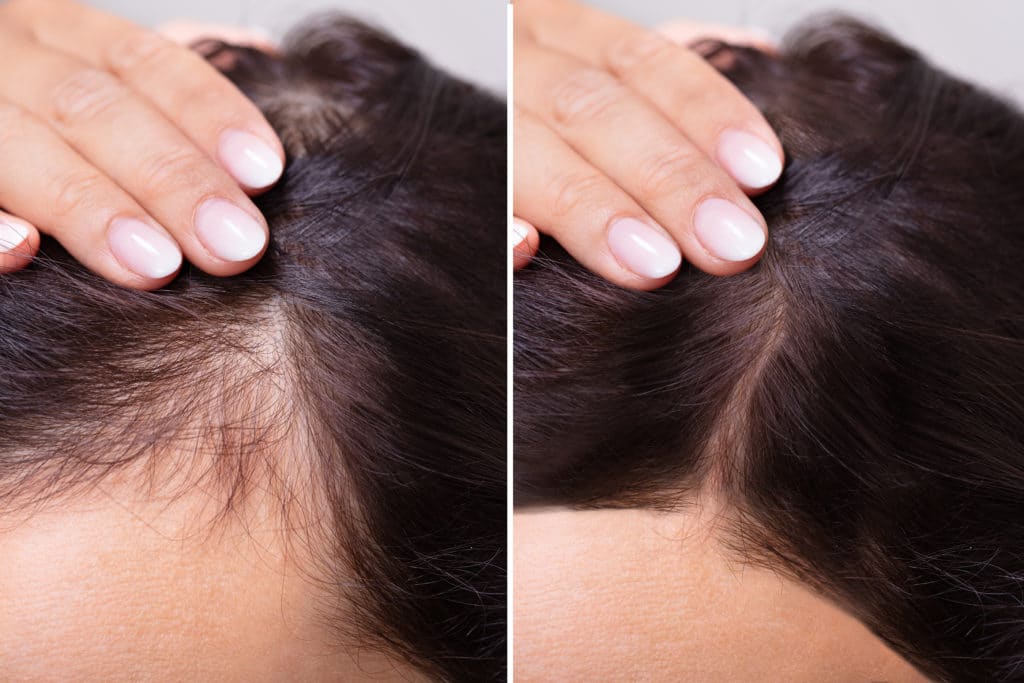PRP for Hair Loss
We all know the role platelets play in our blood. They are critical to wound repair, as they allow the blood to clot. Beyond their clotting prowess, blood platelets are also powerful growth facilitators, which plays another important part in wound healing and skin repair.
You may have heard of professional athletes using platelets to help them return to the game more quickly after injury or surgery. That’s been a common practice for two decades. At Azul Cosmetic Surgery and Medical Spa, Dr. Flaharty puts these same platelets to work for patients with thinning hair. The procedure is called platelet-rich plasma for hair loss prevention, and it helps patients stop losing their hair and start regrowing new hair. And it does so using nothing but the patient’s own platelets.
How Does PRP Therapy Work?


What is platelet-rich plasma?
Platelet-rich plasma (PRP) simply takes a typical blood sample and removes the red blood cells. What is left is concentrated blood platelets, white blood cells, and plasma — platelet-rich plasma. This is now a powerful healing serum that is fueled by seven growth factors. In the body, growth factors are the messengers between cells, signaling the cells to perform their different functions. In wound healing, they initiate various healing processes.
How is the platelet-rich plasma created?
To make PRP, we first take a small amount of blood, similar to what would be taken for blood work. The blood is placed in a sterile centrifuge where it is separated into its different components. The red blood cells are then removed, leaving concentrated blood platelets, white blood cells, and plasma. This liquid has four times the normal number of platelets, hence the name “platelet-rich” plasma. The process takes just a few minutes.
How does platelet-rich plasma work to prevent hair loss?
Platelet-rich plasma has been an accepted way to speed natural healing in the athletic world for some time, but in the last few years it was discovered that PRP was also effective for helping men and women with thinning hair. It works directly on the hair follicles.
The problem with hair loss or thinning hair is that more and more hair follicles are moving into long-term resting or even dormant stages of the growth cycle. With PRP for hair loss prevention, the idea is to use the growth factors and healing power of the concentrated platelet serum to keep more hair follicles from moving into the dormant phase of the growth cycle. When PRP is injected into the area, its growth factors and other healing qualities are able to kick start dormant hair follicles back to the anagen/growth phase of the hair lifecycle. So, those areas that have been thinning can begin to regrow hair and fill back in.
How long will it take to start growing hair?
The first goal for Dr. Flaharty with these treatments is to stem the patient’s hair loss. That’s the thing you will notice first, a marked decrease in hair shedding. From there, real growth usually is noticeable after the first two to three months.
How Does PRP Therapy Compare With Other Options?
There are medications such as Minoxidil and Finasteride that are FDA approved for treatment of hair loss. Both medications must be taken consistently for an extended amount of time to see effects and can have several side effects.
Hair transplant is another option but requires incisions in the scalp and a long recovery time.
Would I be a good candidate for PRP treatment for hair loss?
 If you are experiencing hair loss, you’re basically a good candidate for PRP hair restoration with Dr. Flaharty. However, the growth factors in the PRP work best when awakening follicles that only recently became dormant. These hair follicles are still healthy and capable of growing hair, but they are spending more and more time in the dormant phase. That’s why PRP hair restoration works best when the patient notices early hair loss. Clinically, this is known as androgenic alopecia.
If you are experiencing hair loss, you’re basically a good candidate for PRP hair restoration with Dr. Flaharty. However, the growth factors in the PRP work best when awakening follicles that only recently became dormant. These hair follicles are still healthy and capable of growing hair, but they are spending more and more time in the dormant phase. That’s why PRP hair restoration works best when the patient notices early hair loss. Clinically, this is known as androgenic alopecia.
If that sounds like you, then PRP could be a great option to stop your hair loss and start regrowing new hair. But there are two groups who cannot have PRP:
- If you have an underlying disorder such as thyroid disease or lupus. These conditions will continue to cause hair loss over time.
- If you are taking blood thinners, PRP is not as effective.
What Patients Are Less Likely To Have Good Results With PRP
Patients with underlying medical disorders such as Thyroid disease, or Lupus because these can cause hair loss over time. If these conditions are adequately treated and in a dormant stage then PRP therapy can be helpful. Patients who are on blood thinners that affect the platelets, or with conditions that decrease the platelet count in the body (thrombocytopenia)
How Does PRP For Hair Loss Work
PRP (platelet rich plasma) is a cutting-edge technology that uses the body’s own growth factors, in a concentrated form applied to the scalp to catalyze hair growth. A simple blood draw is all it takes to harvest your own natural growth factor rich platelets that can then be processed and injected into your scalp to re vitalize your hair!
What Are Growth Factors?
Growth factors are cells and proteins that promote growth of tissues. The growth factors that PRP treatments introduce into your scalp include platelet-derived growth factors (PDGF) which spurs your hair follicles into action to grow more hair. Another growth factor that is harnessed in these treatments is Vascular Endothelial Growth Factor (VEGF), which Is also present in platelets and supports the microcirculation to the hair follicles to support growth and increase thickness of existing hair.
How is the PRP injected into the scalp and is it painful?
Now that we have the PRP, Dr. Flaharty then injects it back into the scalp using a special syringe with three needles. The PRP is injected at approximately every half inch across the area of thinning hair. The injections are not at any depth, so they aren’t painful. Still, topical numbing agent can be applied prior to the PRP session.
Is there recovery after a PRP treatment for hair loss?
There isn’t really any recovery. You may take an over-the-counter pain medication if you feel any soreness, but you can shower and wash your hair immediately. We recommend holding off one to two days with typical hair maintenance, such as blow drying, coloring, curling, etc. It’s best to just let the PRP settle in and get down to work.
How Many Treatments Are Required?

Studies show that the best results are seen after 3 treatments separated by one month, followed by a repeat treatment 6 months later, and then treatments every 6 to 12 months after that.
What Else Can I Do To Help With Hair Growth?
There are several FDA approved medications that can help with hair loss and can be used in conjunction with PRP injections. They include over the counter available Minoxidil (Rogaine) which can be used on both men and women, and finasteride (Propecia), which requires a doctors prescription and is approved for men.
What Are The Risks Of PRP?
As with any treatment that involves injections there is the risk of bruising, discomfort and rarely infection. Infection is extremely rare and sterile technique is used in every step of the procedure. There is also the risk that PRP may not help your hair loss. PRP is not FDA approved for the treatment of hair loss but has shown incredible results in studies and is FDA approved for joint and various orthopedic injections.
How many PRP hair restoration sessions will I need?
Dr. Flaharty recommends one PRP treatment per month for three to four months, with follow-up treatments every three to six months, depending on the patient’s response to treatment. For most patients with thinning hair or pattern baldness, this is viewed as an ongoing maintenance program to overcome the tendency for the hair follicles to become dormant.
What are the risks with PRP hair loss treatment?
A great thing about PRP, besides its phenomenal healing properties, is that it comes from your own body, so there aren’t any reactions to these injections. The main aftereffects can be some lingering pain at the injection sites, slight bleeding, and a small risk of infection. These risks are very small.
What Research Has Been Done On PRP Hair Rejuvenation?
Results from recent peer reviewed scientific studies have shown that PRP is a highly effective form of hair rejuvenation treatment. One study demonstrated that PRP is more effective than Minoxidil (Rogaine). A review of the medical literature written on the topic of PRP found that 85% of literature found that PRP is an effective treatment for restoring and revitalizing hair in adults who suffer from alopecia (hair loss)
Several studies both in orthopedic literature and in hair specific studies have demonstrated that there is a “magic number” of platelets needed to reach the maximum growth factor density for the best results. This platelet density is reached using the techniques used in your treatment, so that your hair has the best growth environment.

Schedule a Consultation Today!
To learn more about PRP Hair Loss Therapy, or to determine whether you are a candidate for the procedure, please schedule a consultation at one of our three offices in Fort Myers, Bonita Springs, or Naples. Call 239.415.7576 or click here to send us an Email Contact Form, and our staff will get back to you at the earliest. Our practice looks forward to serving you!

